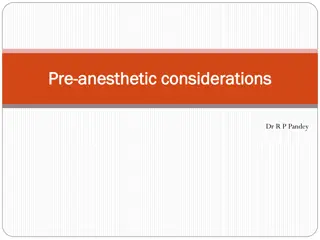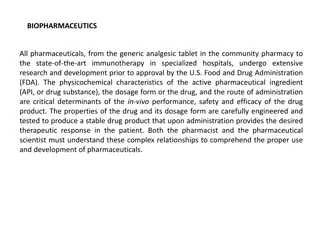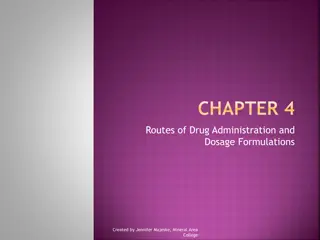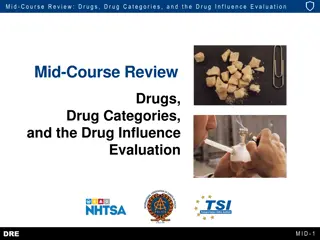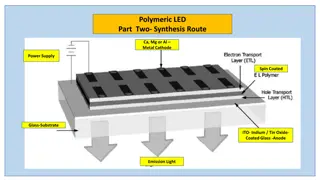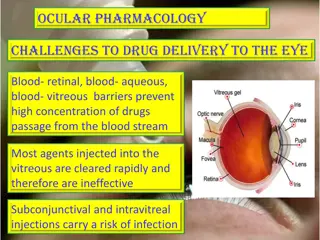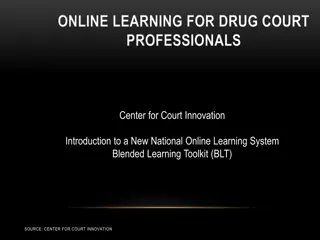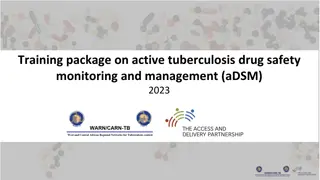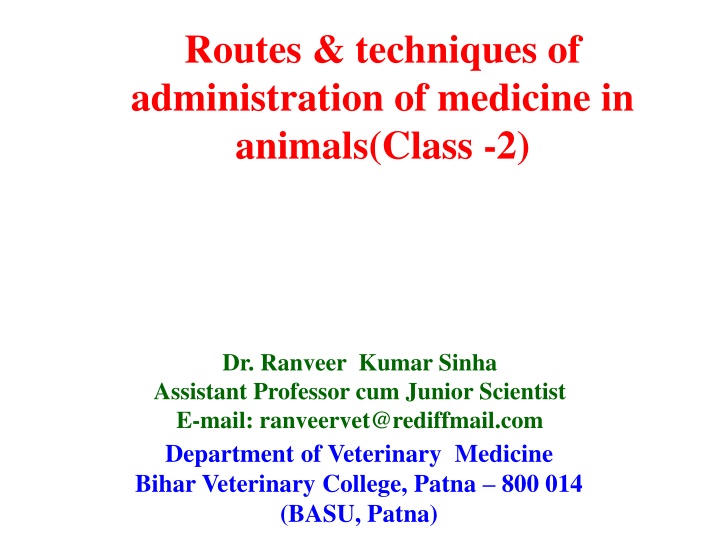
Veterinary Medicine: Routes & Techniques of Medication Administration in Animals
Learn about different routes and techniques of administering medicine to animals, including subcutaneous, intramuscular, intravenous, intra-peritoneal, and more. Understand the factors to consider for each method to ensure effective treatment with minimal discomfort.
Download Presentation

Please find below an Image/Link to download the presentation.
The content on the website is provided AS IS for your information and personal use only. It may not be sold, licensed, or shared on other websites without obtaining consent from the author. If you encounter any issues during the download, it is possible that the publisher has removed the file from their server.
You are allowed to download the files provided on this website for personal or commercial use, subject to the condition that they are used lawfully. All files are the property of their respective owners.
The content on the website is provided AS IS for your information and personal use only. It may not be sold, licensed, or shared on other websites without obtaining consent from the author.
E N D
Presentation Transcript
Routes & techniques of administration of medicine in animals(Class -2) Dr. Ranveer Kumar Sinha Assistant Professor cum Junior Scientist E-mail: ranveervet@rediffmail.com Department of Veterinary Medicine Bihar Veterinary College, Patna 800 014 (BASU, Patna)
SC Injections Factors to Consider: Use An 18 or 20 gauge needle, 1 to 1.5 inches long. SC medications are deposited into the loose connective tissue just below the dermis. This tissue is not richly supplied with blood vessels so the absorption rate is slow. There are many pain receptors in this tissue so only non- irritating, water-soluble medications in small doses should be given by the SC route.
Intramuscular Injected deep into the body of a muscle Less likely to cause an overt tissue reaction Insert needle at right angles to the skin Larger volumes may be injected in the one site than with other routes Faster absorption than s/c Factors to Consider: Intramuscular injections may be performed in the thigh muscles on the front of the rear limb, or using the hamstring muscles on the back side of the rear leg If blood is aspirated, the needle should be removed as this indicates needle placement in a blood vessel. Reinsert the needle at a different site. Needle sizes used for IM injections range from 25 to 20 gauge. Muscle is dense tissue and can only accommodate small volumes of fluid
IV,IP & IC Intravenous (IV) Into the vein directly Fastest onset of action Can give irritant solutions into the vein which cannot be given IM or SC Irritant drugs should be given via an intravenous catheter, (caparsolate, thiopentone, guifenasin) Intra-peritoneal (IP) Into peritoneal cavity Usually near umbilicus or half way between umbilicus & pubis Used for- Rodents, Birds, Euthanasia of young difficult patients Intra-cardiac (IC) Injection through the chest wall into the heart Emergency administration of drugs during cardiac resuscitation e.g. adrenaline, Euthanasia, Moribund animals
Intrapleural, Intra-articular, Epidural, Subconjunctival Intrapleural Injection into the pleural space through the chest wall Not commonly used Intra-articular Injection into the joint space Needs full surgical preparation should also wear gloves and draw drug up in a sterile manner, new unused bottle, etc, to avoid introduction of infection. Used for Dogs (eg cortisone with greyhounds, Cartrophen) Epidural Injection into the epidural space surrounding the spinal cord usually in the lumbar site Full sterile prep needed Animal positioned on sternum, with back legs drawn forwards Used for- Before an orthopaedic procedure on spine or hindquarters, Pain relief (eg morphine, local anaesthetic for dog), Stops straining and gives pain relief, (lignocaine, xylazine). Subconjunctival Into the conjunctiva of the eye Use a fine needle Needs good restraint Used for Ocular conditions
Topical Topical medications External surfaces eg. the skin, eyes, ears Exposed mucous membranes eg gums, nasal mucosa, prepuce and penis, vulva and vagina. Medication may work Topically - on only the area to which it is applied (eg ringworm ointment), Systemically (eg Spotton, Ivomec Pour On, DMSO) CREAMS the drug is dissolved in water and mixed with oil or fat. Creams spread easily and penetrate the outer layers of the skin A semi-solid water-soluble emulsion which penetrates the skin surface Tubes or plastic squeeze bottles Wash off with water. OINTMENTS the drugs are present in a base of wax or fat. They do not penetrate the skin. Semi-solid oil-based preparation, usually with a base of wax or jelly Comes in tubes, jars, etc. Does not usually get absorbed by the skin, (eg prednoderm). Suspension Liquid preparation in which particles suspended in the liquid Will separate out on standing, so needs to be shaken, (eg calamine lotion, yellow lotion)
Continue-- Rinse/Wash Solution Liquid which often diluted and poured on an animal May have a residual action when dry, (asuntol, otoderm, ectodex). SPRAYS a way of applying liquids in fine droplet form Liquid under pressure Sprayed on as particles of liquid suspended in air, (eg chloromide, debrisol, frontline, fly repellent) Powder Finely particulate solid preparation which dusted on Can be irritant to open wounds May help to dry weeping wounds, (eg tricin powder, pinkeye powder) MEDICATED SHAMPOOS drugs mixed with detergents which penetrate the coat. Shampoos are left in contact with the skin for the recommended amount of time and then should be rinsed off thoroughly.
Continue-- EYE & EAR MEDICATION EYE & EAR MEDICATIONS these are both examples of topical medication. Eye medications should be sterile. Once they have been opened they should be stored only for the length of time recommended by the manufacturer. Aural medications Drops or Ointments The ear is ideally cleaned of wax and discharge before administration of medication
Continue-- Medications per rectum Enema Suppository Fluid replacement Enema Commercial solutions Syringe, tube Soapy water Other substances - paraffin Suppository Bullet shaped, semi solid, glycerine based Melts at body temperature Can contain antibiotics, laxatives, soothing agents May be absorbed systemically
Continue-- Medications intra-uterine Pessaries Solutions Pessaries Large tablets Usually antibiotic May also have a foaming agent Administered by hand when the cervix is open for example, after a calving Intra-uterine fluids Administered via the cervix with a catheter During oestrus when the cervix is relaxed Some will remain in the uterus, while others will be siphoned out again
What are the risks to animals when administering medicines? Overdose ,Allergic reaction ,Wrong administration route selected ,Animal stressed,Animal gets injured How can these risks be minimised Follow instructions carefully, Make sure that the animal is adequately restrained, Use sprays in a well ventilated area, Wear appropriate PPEs (e.g. gloves, mask etc)

